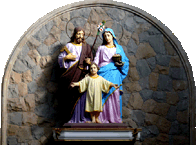|
The Royal Palm is a popular garden tree in tropical regions that grows from 15 to 23 meters tall (50-75 feet). It is the national tree of Cuba.
It has a smoothly sculpted trunk that's swollen at the base, narrower about halfway up and widens again just below the crownshaft. The trunk is a smooth light gray that looks as if it has been cast from concrete. The timber from the trunk is used for construction purposes and to manufacture furniture.
The fruit, also called palm nuts, grow in clusters and are used to make palm oil and pig food since it is not commonly consumed by humans. The clusters that are free of fruit are used as domestic brooms.
The tender shoots and inner core of the trunk are consumed with soups and salads. It was the staple food consumed by the Cuban Army of Liberation during the Independence War between 1895 to 1898. The fronds are used by Cuban peasants to roof their houses and cover tobacco farms as well as on the walls of houses.
Royal Palm produces a large 3' to 4' inflorescense on which both male and female flowers are borne, just at the base of the green crownshaft. It also provides shade and shelter to a number of bird species due to its height.
The genus of this magnificient plant species Roystonea was named by O.F. Cook after General Roy Stone, a United States Army Engineer, due to his fearless energy towards the road building campaign that he headed in Puerto Rico during the Spanish invasion.
IMPORTANT: The information on this website has been compiled from reliable sources, such as reference books. It is not a substitute for medical advice or treatment. Readers should always consult their physician before using or consuming a plant for medicinal purposes.
--- Click here for information about other trees on Holy Family Church campus ---
|
